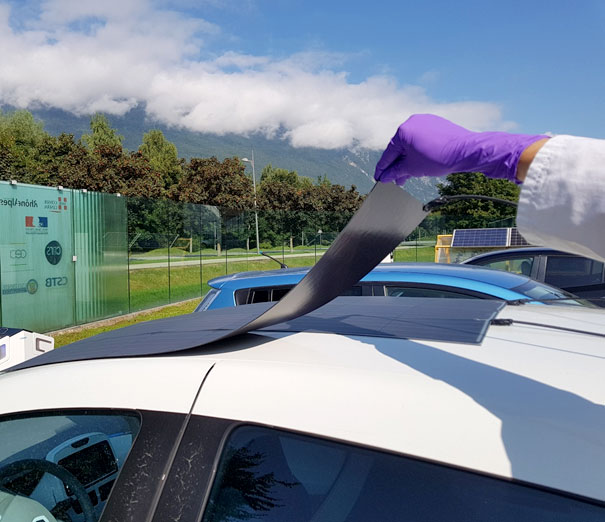The prototype prefigures a non-intrusive solution that is compatible with any rechargeable vehicle, and includes a conformable photovoltaic panel, a battery and an electronic interface. It should in the longer term enable the vehicle to be partially recharged directly from the sun. Tested on a Renault Zoé model, the remote data feedback shows the possible gain up to 4 kilometres per day* when the days are very sunny. Future data collection over several months and several vehicles will make it possible to precisely quantify the contribution in solar kilometres, which is estimated by our researchers at 800 additional kilometres of autonomy** per year. The aim of this demonstration is to stimulate the interest of manufacturers in the sector to move towards an integrated and optimized solution to power the main vehicle battery.
With the growing introduction of electric vehicles, the interest in improving autonomy through additional solar power sources is increasing. A large proportion of the vehicle population is in fact either mobile or stationary, in full sunlight for most of the day. This application of solar energy, known as VIPV for "Vehicle Integrated PhotoVoltaics", is currently being studied by many industrial and research teams, particularly in terms of manufacturing processes and integration of photovoltaics into the vehicle bodywork, as well as the measurement of achievable performance. Studies covering the entire recharging chain (from solar production to its use in vehicle consumption) are less common.
The objective of our teams with this area of research is triple:
- To increase the vehicle's autonomy
- To partially relieve the network during recharging
- Improve user comfort by reducing the frequency of recharging
- To reduce the CO2 impact of the vehicle over its entire life.
According to our calculations, such a kit could increase the range of the demonstrator vehicle by 800 km per year** and reduce the frequency of recharging by 14%, which is not to be underestimated for many uses. By way of illustration - in France and according to the 2019 Personal Mobility Survey of the Ministry of Ecological Transition and Territorial Cohesion *** - 35.7% of home-to-work journeys are less than 5 km away (i.e. 10 km round trip).
The system must be easy to install and remove, and be compatible with any type of rechargeable vehicle. It should eventually supply the vehicle's traction battery directly, with minimal losses between the solar production and the energy stored in the battery. These subsequent stages, necessary for the evolution of the kit, will have to be developed with the relevant manufacturers.
(*) Example for a day in July 2022, in Bourget-du-Lac (Savoie), with a solar kit of 145Wp, and a consumption of 150Wh/km.
(**) for a solar kit with a power of 145Wp
(***) https://www.statistiques.developpement-durable.gouv.fr/resultats-detailles-de-lenquete-mobilite-des-personnes-de-2019
To create the prototype kit, the CEA designed a specific photovoltaic panel with a capacity of 145 Wp, a magnetic rear panel and a mechanical design allowing it to fit onto any metal bodywork. The electronics consist of an MPPT charge controller, associated with a battery and a micro-inverter that can now be used to inject the stored energy into the grid when the vehicle is recharged. At this stage of development, the kit does not allow the main battery to be powered directly, which is its ultimate objective. The system is non-intrusive to the vehicle so it can be adapted to all rechargeable models.

145Wp photovoltaic solar panel produced for the solarisation kit and installed on Renault Zoe. © CEA